Are you struggling with a fruit fly infestation in your kitchen? Flyermedia.net understands the frustration of dealing with these pesky insects, so we’ve compiled a comprehensive guide on how to catch fruit flies effectively. By implementing these strategies, you can maintain a clean and enjoyable kitchen environment. Discover effective fruit fly control methods and natural fruit fly remedies to reclaim your kitchen today.
1. What Exactly Are Fruit Flies?
Fruit flies are small flying insects known for their attraction to ripe fruits and vegetables, as their name implies. Besides fruits, they are also drawn to sugary or fermented drinks like beer, wine, and juice. You’ll often find them buzzing around fruit bowls, garbage cans, and even kitchen drains. These tiny insects are about the size of a grain of rice, resembling small, tan, or brownish houseflies with distinctive red eyes. They typically appear during the summer or late fall when fruits are in season.
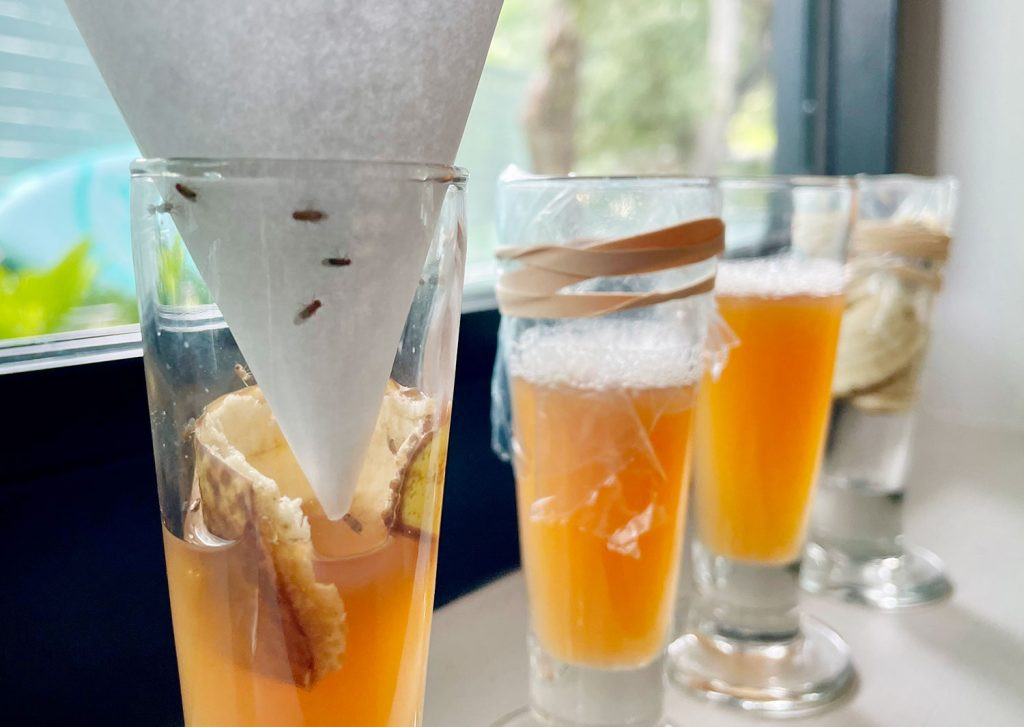 Fruit Flies Trapped In DIY Funnel Trap Method
Fruit Flies Trapped In DIY Funnel Trap Method
The start of a fruit fly problem can be traced back to just a few of these bugs hitching a ride home on a piece of fruit. Female fruit flies can lay hundreds of eggs during their short lifespan, with eggs hatching in as little as 12 hours. These flies can reach adulthood in just a few days, which means a small group of pests can quickly turn into a large swarm. Because of their rapid reproduction, it’s important to take immediate action to eliminate fruit flies as soon as you notice them.
1.1. Fruit Flies Vs. Fungus Gnats Vs. Drain Flies: What’s The Difference?
It’s easy to mistake fruit flies for other common household pests, especially fungus gnats and drain flies. All three are small flying insects, but identifying them correctly is essential for choosing the right elimination method. One of the easiest ways to tell them apart is by where you spot them and what larger insect they resemble.
- Fruit flies look like small flies. They are typically found near fruit bowls, trash cans, or other sources of decaying food.
- Drain flies look like small fuzzy moths. They are usually found near sinks and drains.
- Fungus gnats look like small mosquitoes. They are commonly found near houseplants, where they breed in damp soil.
If you’re uncertain, try one of the traps mentioned later in this article. If it attracts the pests in your home, you likely have fruit flies.
2. Effective DIY Fruit Fly Traps You Can Make at Home
Getting rid of fruit flies doesn’t have to be complicated or expensive. With just a few household supplies and a bit of patience, you can create effective traps to eliminate these pests. Each trap follows the same basic principle: attract the fruit fly and prevent it from escaping.
We’ve tested four DIY methods, and there was a clear winner. Since each method uses items you probably already have, it doesn’t hurt to try more than one.
Here are the four methods we tested:
- Funnel Trap
- Plastic Wrap Trap
- Dish Soap Trap
- Rotting Fruit Trap
 4 DIY Fruit Fly Traps Tested On Windowsill
4 DIY Fruit Fly Traps Tested On Windowsill
Below, we’ll share more details about each method, including our verdict on which one worked best. Keep in mind that some traps work faster than others, and it may take several days to completely get rid of your fruit fly problem.
2.1. How To Make A Funnel Fruit Fly Trap
This trap lures fruit flies into a container through a small hole in the bottom of a homemade paper funnel. Once inside, the flies struggle to escape through the small opening.
Supplies needed:
- Small clear jar, cup, or container (preferably with a narrow opening)
- Piece of paper or cardstock
- Tape
- Scissors
- Apple cider vinegar (ACV)
Instructions:
- Choose your container: Find a small, clear container such as an old food jar or plastic soda bottle. A narrow opening is ideal for this method.
- Add apple cider vinegar: Pour a small amount of apple cider vinegar, old beer, or wine into the bottom of the container. The sweet, fermented smell will attract the fruit flies.
- Make your funnel: Roll a piece of paper or cardstock into a cone shape with a very small opening at the tip. Secure the shape with tape. You can also cut the opening at the end if that’s easier. The opening should be about the size of a grain of rice.
- Set your funnel: Place the paper cone into the opening of the container. You may need to reshape the funnel so it rests on top of the opening without touching the ACV. Make sure it fits snugly against all edges of the opening to prevent flies from escaping.
- Optional outdoor ending: Carefully take the entire trap outside, making sure not to disturb the funnel. Once outside, remove the funnel to let the trapped flies escape.
You can also use a store-bought funnel, but the opening at the bottom might be too large, allowing too many fruit flies to escape.
2.2. How To Make A Plastic Wrap Fruit Fly Trap
Similar to the funnel trap, this method attracts fruit flies with the scent of apple cider vinegar. The flies enter through small holes in the plastic-wrapped top but struggle to find their way out.
Supplies needed:
- Small clear jar, cup, or container
- Rubber band
- Plastic wrap or plastic bag
- Toothpick
- Apple cider vinegar (ACV)
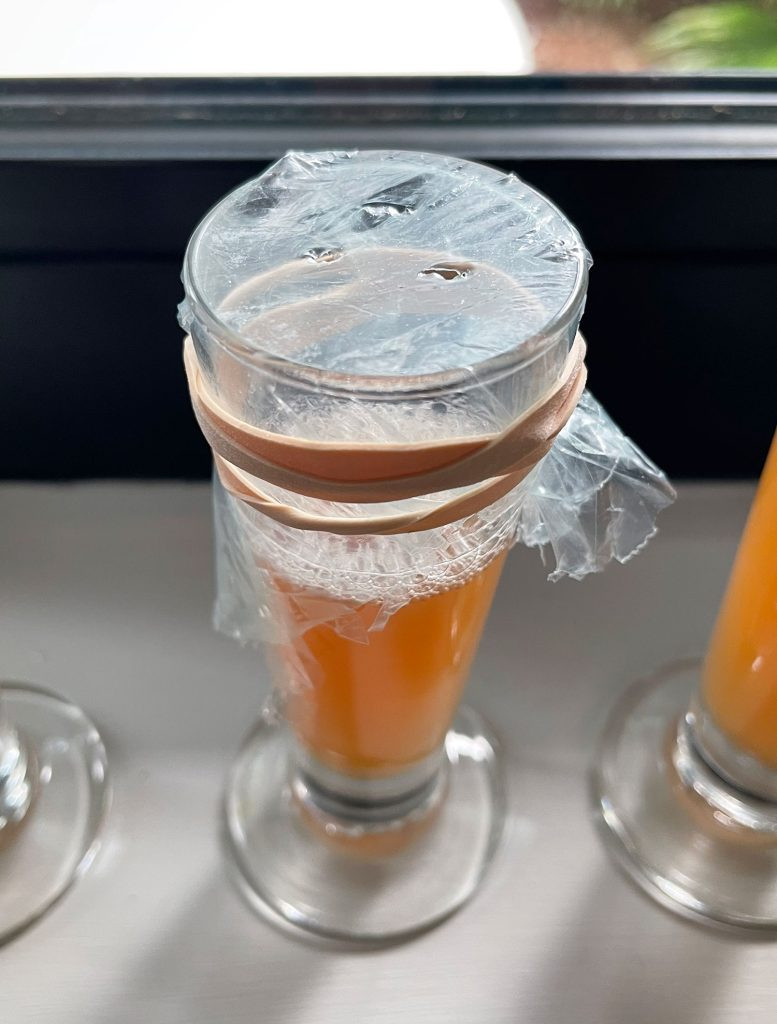 DIY Fruit Fly Trap With Apple Cider Vinegar And Plastic
DIY Fruit Fly Trap With Apple Cider Vinegar And Plastic
Instructions:
The steps for creating this plastic wrap trap are similar to the funnel trap. Here are the steps:
- Choose your container: Find a small, clear jar, cup, or another glass container. The container doesn’t need to be large. A clear container makes it easier to see the trapped flies, but an old soda or beer can also works.
- Add apple cider vinegar: Pour apple cider vinegar into the container. The scent will attract the flies. Old beer or wine also works, but white vinegar doesn’t.
- Cover with plastic: Tightly cover the opening with plastic wrap and secure it with a rubber band. Saran wrap works, but you can also use scraps from a plastic bag.
- Poke small holes: Use a toothpick to poke a few small holes in the top of the plastic. The holes should be large enough for a fly to fit through, but not too big.
- Optional outdoor ending: Carefully take the entire contraption outside without removing the plastic wrap. Remove the cover and let the flies escape.
This technique can also be done by poking a hole in the lid of a metal jar. Use a mason jar or an old food jar, and use a hammer and nail to puncture the top.
2.3. How To Make A Dish Soap Fruit Fly Trap
Unlike the previous two methods, this trap doesn’t require any covers. Instead, it relies on a soapy surface to trap the fruit flies, preventing them from flying away. Note: this one doesn’t allow you to set them free outside, as they get coated in the soap.
Supplies needed:
- Small container, bowl, or dish
- Dish soap
- Apple cider vinegar (ACV)
Instructions:
The steps for making this trap are extremely simple.
- Put out some apple cider vinegar: Fill the bottom of a small container, bowl, or dish with apple cider vinegar. The scent will attract the fruit flies.
- Add dish soap & mix: Squirt several drops of dish soap into the ACV and mix to create a soapy solution. The flies will land on the mixture and become trapped.
This technique can also be combined with the plastic wrap or funnel method. Just add some dish soap to the apple cider vinegar before covering the top. This introduces another way for the flies to get stuck.
2.4. How To Make A Rotting Fruit Fly Trap
We also tested some traps by swapping apple cider vinegar for what fruit flies love most: actual fruit.
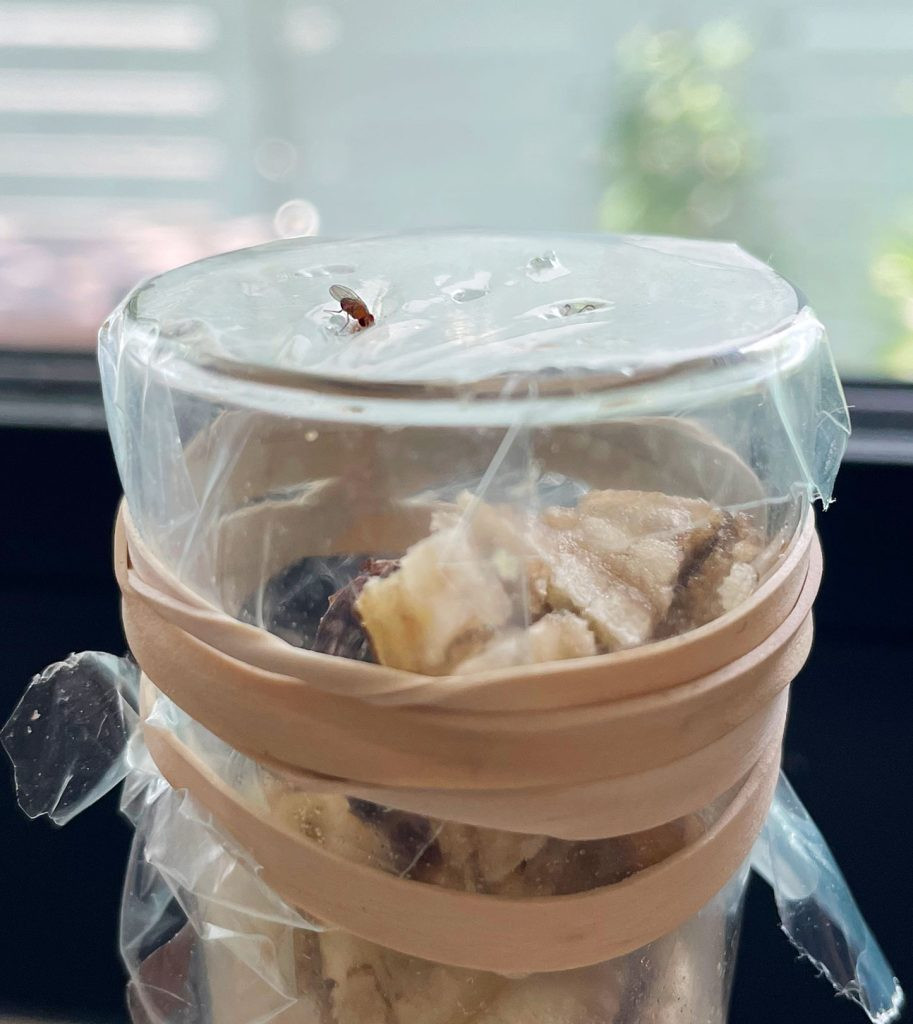 Fruit Fly Entering Plastic Wrap On DIY Trap
Fruit Fly Entering Plastic Wrap On DIY Trap
Supplies needed:
- Small glass jar, cup, or container
- Plastic wrap or paper funnel, depending on your chosen trap mechanism
- A small fruit scrap, such as a banana peel or apple slice
Instructions:
To create a rotting fruit trap, substitute apple cider vinegar with a piece of banana peel, apple slice, or peach in either the plastic wrap or funnel trap. You can also add the fruit scrap to your ACV. Be prepared to swap out the fruit scrap every day or two to prevent unwanted smells in your kitchen.
3. What Is The Most Effective Fruit Fly Trap?
We set out four different DIY traps to see which performed the best. The homemade traps we tested were a combination of techniques:
- Plastic Wrap Trap with banana peel
- Funnel Trap with ACV + banana peel
- Plastic Wrap Trap with ACV + soap
- Dish Soap Trap with ACV
For us, the clear winner was less about the type of trap and more about the bait. Anything with banana peel performed much better than apple cider vinegar alone. Our two plastic wrap traps were nearly identical, but the one with the banana peel dramatically outperformed the one with ACV and soap. Maybe ACV is less enticing when there’s real fruit nearby.
Our suggestion would be – no matter what trap you set up – add a fruit scrap to it! We had a slight preference for the plastic wrap trap because it was easier to make and less prone to disruption. I accidentally knocked over our funnel once and released half of the flies back into the kitchen. Oops.
4. Understanding Fruit Fly Attraction: What Attracts Fruit Flies the Most?
We wanted to continue this experiment. Since we had such good luck using fruit scraps, we wanted to test which kind of fruit was the best bait. We used three fruits we already had on hand: a banana peel, apple slices, and a strawberry. We put each in a plastic wrap trap side-by-side on our countertop for 24 hours.
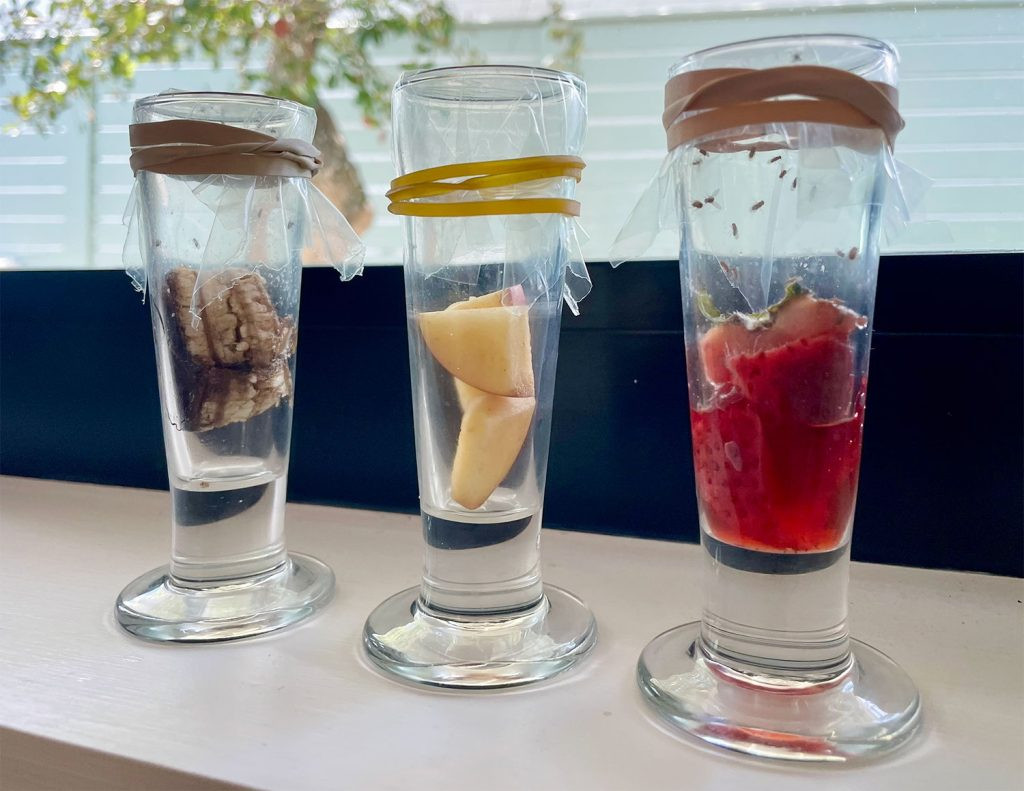 Fruit Fly Traps With Different Rotten Fruit Baits
Fruit Fly Traps With Different Rotten Fruit Baits
Although the banana peel started off strong (it was the most rotten at the beginning), the fruit flies ended up being the most attracted to the strawberry. The banana peel still caught several flies, but the longer the strawberry rotted, the more flies it caught. The apple slices didn’t catch a single one.
This experiment confirms that while fruit flies are attracted to ripe and rotting fruit in general, they have preferences. Strawberries, with their strong, sweet aroma, appear to be particularly irresistible to these pests.
5. Effective Store-Bought Fruit Fly Traps
If you’re not having any luck with DIY solutions or don’t have the time or materials to make them, there are premade traps you can buy instead. These traps often have thousands of positive reviews and typically cost less than $20. They might be worth considering if you want something that catches other types of flying insects or if you prefer a more discreet option.
During our little experiment, I picked up a pack of Terro Traps to see if they performed better than my homemade methods. I left one out for 24 hours next to our banana and strawberry traps to see which of the three performed best.
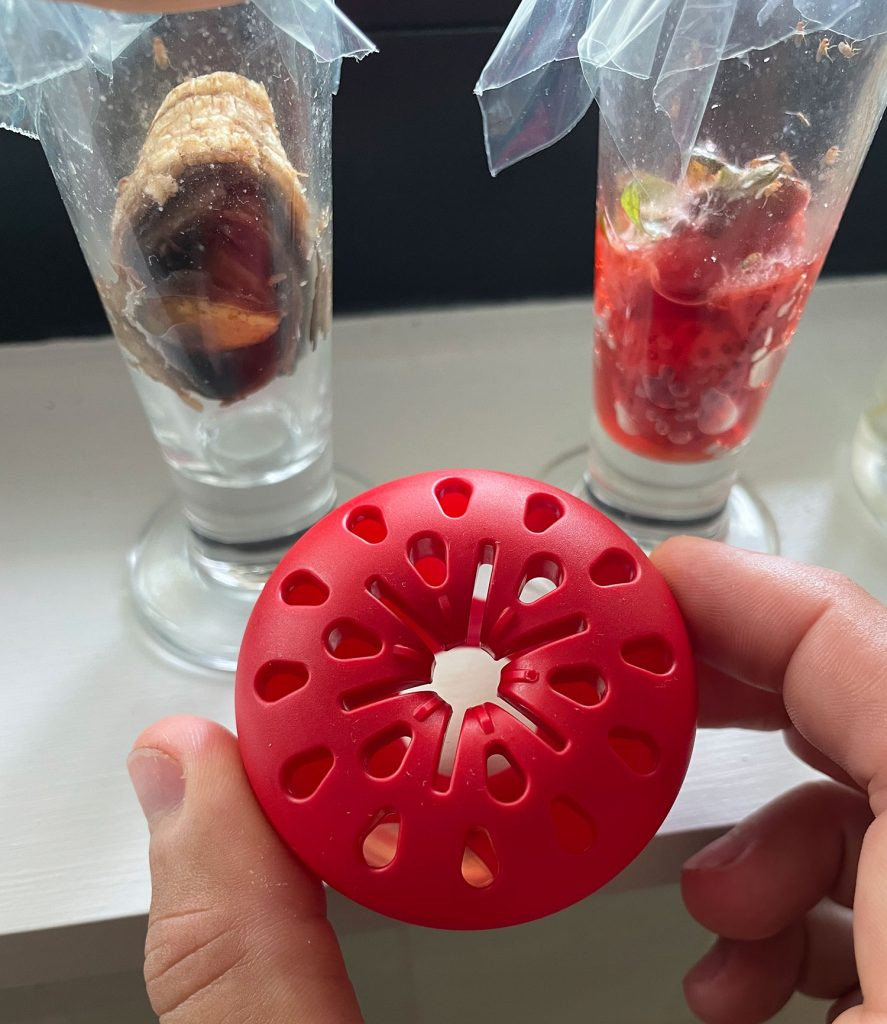 Terro Fruit Fly Apple Trap With No Fruit Flies In It
Terro Fruit Fly Apple Trap With No Fruit Flies In It
Once again, our homemade strawberry trap did best, followed closely by the homemade banana peel trap. The store-bought trap caught only one. However…
Just to be sure, we discarded both of our DIY traps and left the store-bought trap out for another 24 hours. That’s when it caught the collection you see above. So it definitely worked, just not as well or as fast as our homemade traps did. Our verdict? Use store-bought traps if you want something more discreet looking, especially if you plan to leave it out indefinitely, but there is nothing bad about the homemade ones. In fact, we found them to be the best way to get the fruit flies right away.
| Trap Type | Pros | Cons |
|---|---|---|
| DIY Fruit Trap | Cost-effective, uses household items, effective | Requires preparation, may not be as aesthetically pleasing |
| Store-Bought Trap | Discreet, catches various insects, low maintenance | Can be less effective initially, may contain chemical attractants |
6. How To Prevent Fruit Flies: Proactive Strategies
Getting rid of fruit flies is pretty simple, but the best-case scenario is to stop them from invading in the first place. Here are some simple ways you can prevent fruit flies from taking up residence in your home.
- Clean kitchen surfaces: Wipe down kitchen counters, stovetops, tables, and any other surfaces that may collect food residue or spilled liquids. Fruit flies are especially attracted to fruit, sweet juices, and alcohol, so don’t let those sit.
- Take out your trash: Leaving food scraps in your garbage overnight can quickly turn your trash can into a fruit fly breeding ground.
- Dispose of overripe fruit: Monitor your fruit bowl for browning or rotting apples, bananas, etc., so you can get rid of them before they become a problem.
- Wash your fruit as soon as you get it home: You can eliminate eggs or larvae that might come home from the store by washing produce right away (except for berries, which could rot faster from the moisture).
- Store produce in the fridge when possible: Fruit flies won’t flourish in the cold, so when in doubt, try storing your fruit and vegetables in the refrigerator.
- Clean your sink drain: Food scraps left in your drain can also attract fruit flies, so make sure you run your garbage disposal and/or flush the drain regularly.
The University of California, Davis, a leading institution in agricultural research, emphasizes the importance of sanitation to control fruit flies. According to their entomology department, removing breeding sites is crucial for effective fruit fly management.
7. Additional Tips for Fruit Fly Control
Beyond the traps and preventative measures, here are a few extra tips to help you keep fruit flies at bay:
7.1. Seal Cracks and Openings
Seal any cracks or openings in your kitchen, especially around windows and doors, to prevent fruit flies from entering your home.
7.2. Regularly Clean Spills
Promptly clean up any spills, especially sugary drinks, juice, or alcohol, as these can attract fruit flies.
7.3. Use Screens
Install screens on windows and doors to keep fruit flies out while still allowing fresh air to circulate.
7.4. Keep Your Compost Bin Clean
If you have a compost bin, make sure to keep it clean and properly sealed. Regularly empty the bin to prevent fruit flies from breeding.
7.5. Check Incoming Plants
If you bring new plants into your home, inspect them for signs of fruit flies or other pests before placing them in your kitchen.
8. Expert Insights on Fruit Fly Behavior
Understanding the behavior of fruit flies can help you target your control efforts more effectively. According to a study published in the “Journal of Economic Entomology,” fruit flies are highly attracted to volatile organic compounds (VOCs) emitted by fermenting fruits and vegetables. These VOCs act as chemical signals, guiding the flies to potential food sources.
8.1. Life Cycle of Fruit Flies
The life cycle of a fruit fly consists of four stages: egg, larva, pupa, and adult. The entire cycle can be completed in as little as eight days under favorable conditions. This rapid reproduction rate is why fruit fly infestations can quickly become overwhelming.
8.2. Fruit Fly Sensory Perception
Fruit flies have highly developed sensory organs that allow them to detect odors and visual cues from long distances. Their antennae are covered in specialized receptors that can detect even trace amounts of VOCs. They also have compound eyes that are sensitive to movement and light.
8.3. Mating Behavior of Fruit Flies
Fruit flies typically mate near their food source. Males perform elaborate courtship rituals to attract females, including wing displays and pheromone release. After mating, females lay their eggs on or near fermenting fruits and vegetables.
9. What To Do If The Infestation Persists
If you’ve tried the above methods and still have a fruit fly problem, don’t worry. Here are a few more steps you can take:
- Contact a Pest Control Professional: If you’re dealing with a severe infestation, it may be time to call in a professional pest control service. They have the tools and expertise to effectively eliminate fruit flies and prevent future infestations.
- Check for Hidden Breeding Sites: Fruit flies can breed in unexpected places, such as garbage disposals, mop buckets, and even damp rags. Thoroughly inspect your kitchen and other areas of your home for potential breeding sites.
- Consider a Commercial Fruit Fly Killer: There are several commercial fruit fly killers available on the market. These products typically contain a combination of attractants and insecticides that can quickly eliminate fruit flies.
10. FAQ: Your Questions About Fruit Flies Answered
- What causes fruit flies in the kitchen?
Fruit flies are attracted to ripe, rotting, or fermented fruits and vegetables, as well as sugary liquids. They can enter your home through open windows or doors, or they may hitch a ride on fruits and vegetables brought in from the store. - Are fruit flies harmful to humans?
Fruit flies are generally not harmful to humans. They do not bite or sting, and they do not transmit diseases. However, they can be a nuisance due to their presence in the kitchen and their ability to contaminate food. - How long do fruit flies live?
Adult fruit flies typically live for about 40 to 50 days. - Can fruit flies breed in drains?
Yes, fruit flies can breed in drains if there is a buildup of organic matter, such as food scraps or hair. Regular cleaning of drains can help prevent fruit fly breeding. - Are fruit flies attracted to light?
Fruit flies are not strongly attracted to light, but they may be drawn to it indirectly if it illuminates a food source that they are attracted to. - Can fruit flies fly long distances?
Fruit flies are not strong fliers, but they can travel short distances in search of food and breeding sites. - How can I tell if I have a fruit fly infestation?
The most obvious sign of a fruit fly infestation is the presence of small flying insects in your kitchen, especially around fruits, vegetables, and other sugary substances. - What is the best way to eliminate fruit flies?
The best way to eliminate fruit flies is to combine preventative measures, such as cleaning surfaces and storing produce properly, with traps to capture and kill the adult flies. - Do fruit flies carry diseases?
Fruit flies are not known to transmit diseases to humans, but they can contaminate food with bacteria and other microorganisms. - Are there any natural repellents for fruit flies?
Some natural repellents for fruit flies include essential oils such as peppermint, eucalyptus, and lavender. Placing cotton balls soaked in these oils near potential breeding sites may help deter fruit flies.
Dealing with a fruit fly infestation can be frustrating, but by understanding their behavior and implementing effective control measures, you can reclaim your kitchen and enjoy a pest-free environment.
Lastly, don’t panic when you spot fruit flies in your home. Yes, you want to take action quickly to prevent the problem from getting worse. But the solutions in this post are easy, effective, and fast-acting.
At flyermedia.net, we’re committed to providing you with the most up-to-date information and resources to help you maintain a clean and healthy home. If you’re interested in learning more about pest control or other home maintenance topics, be sure to explore our website for more helpful articles and tips.